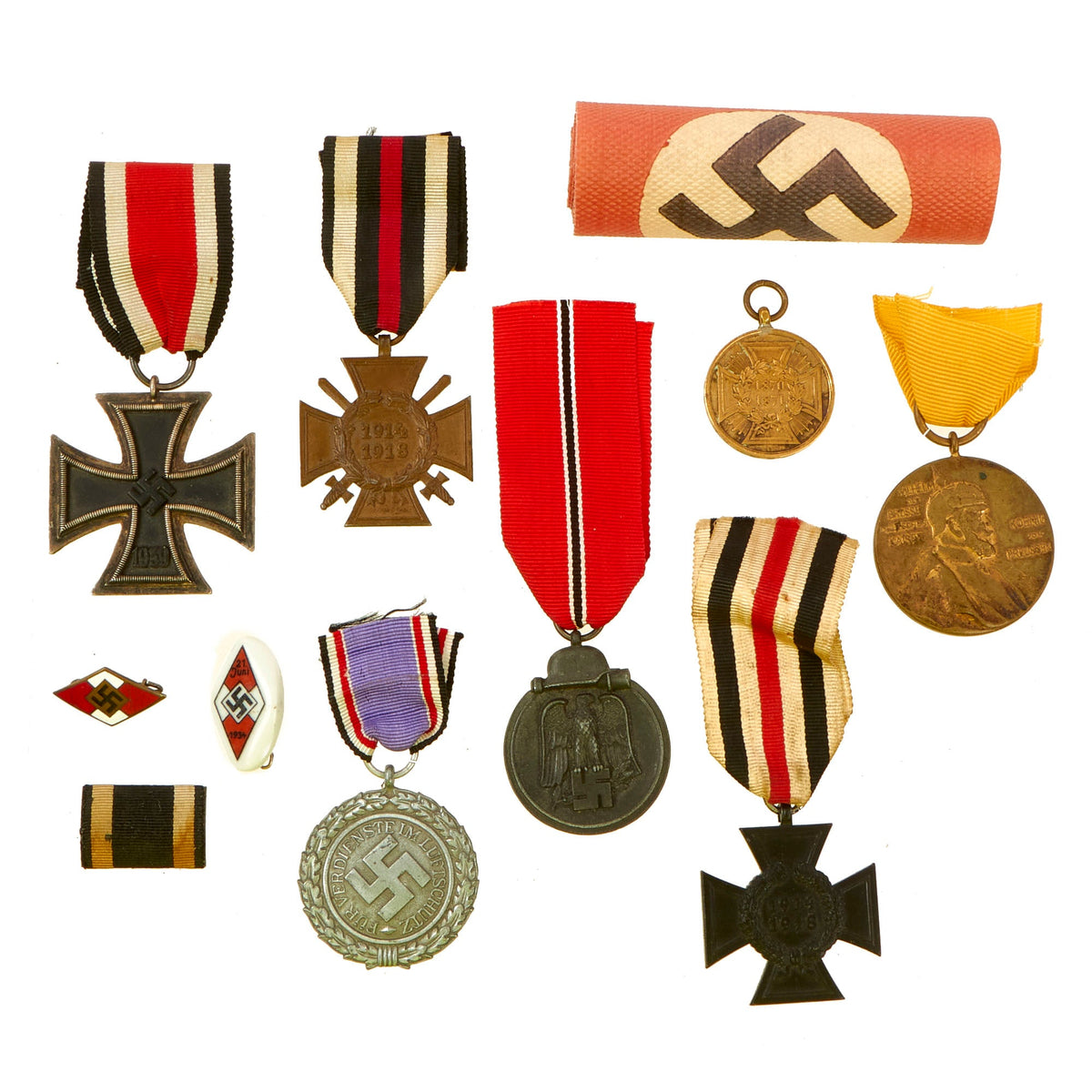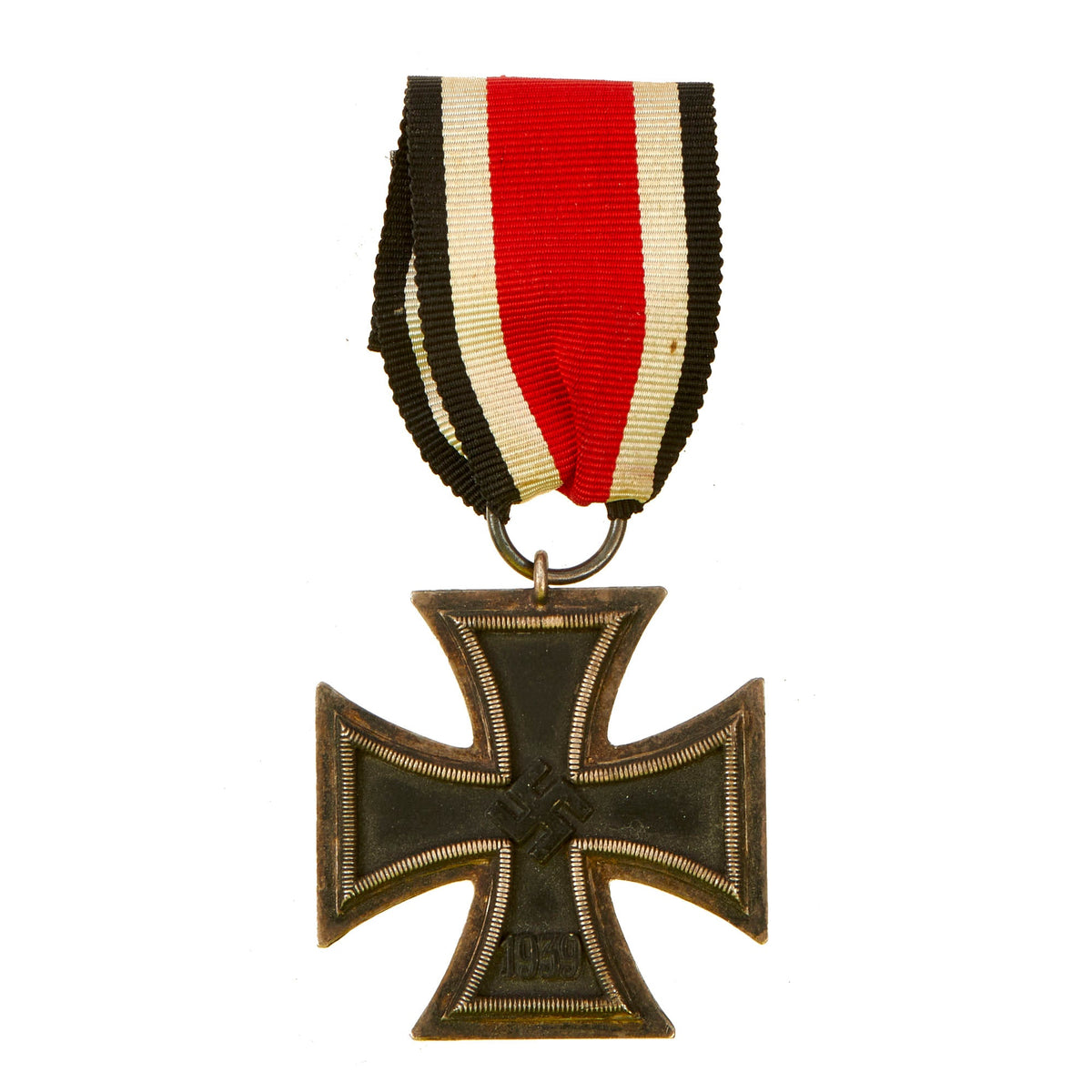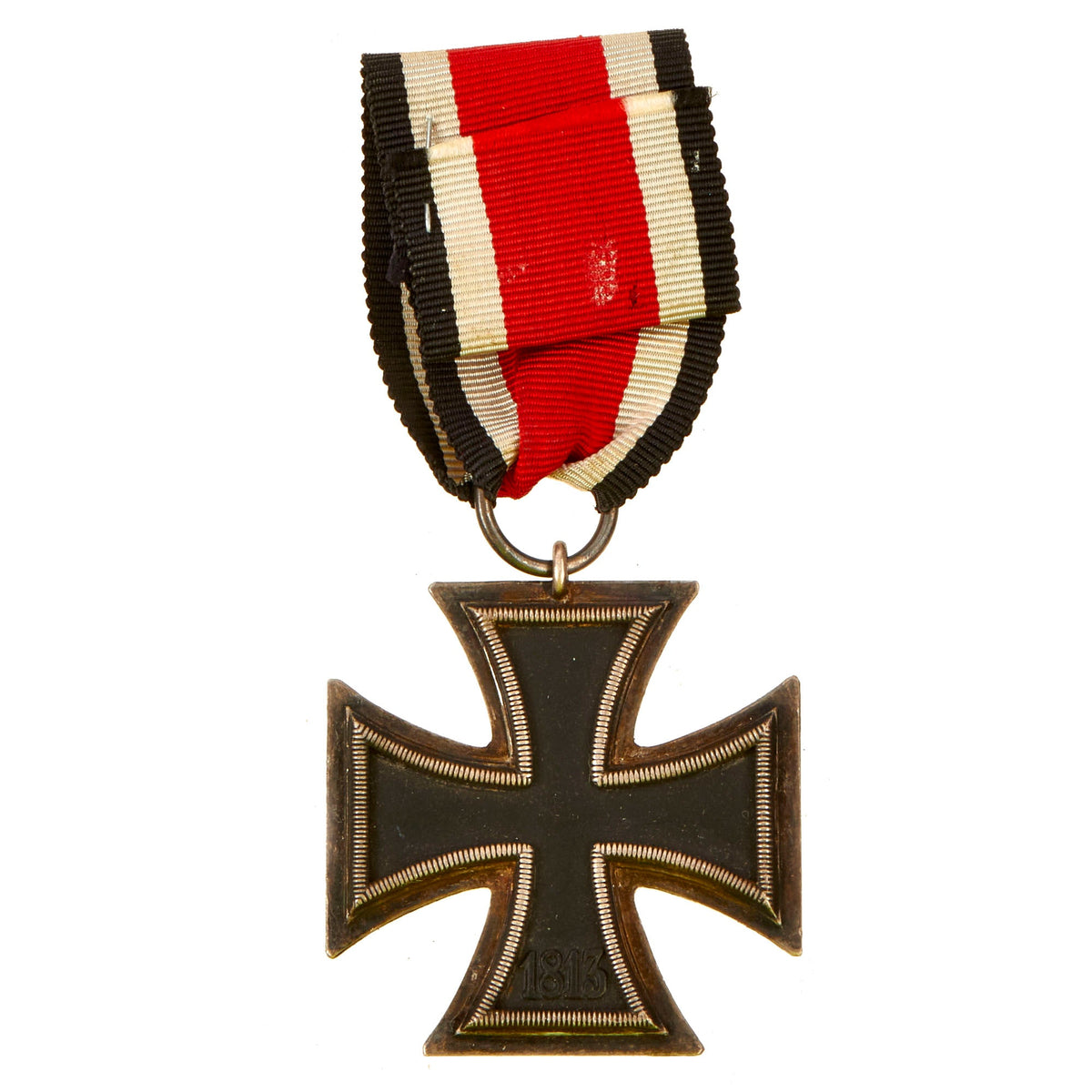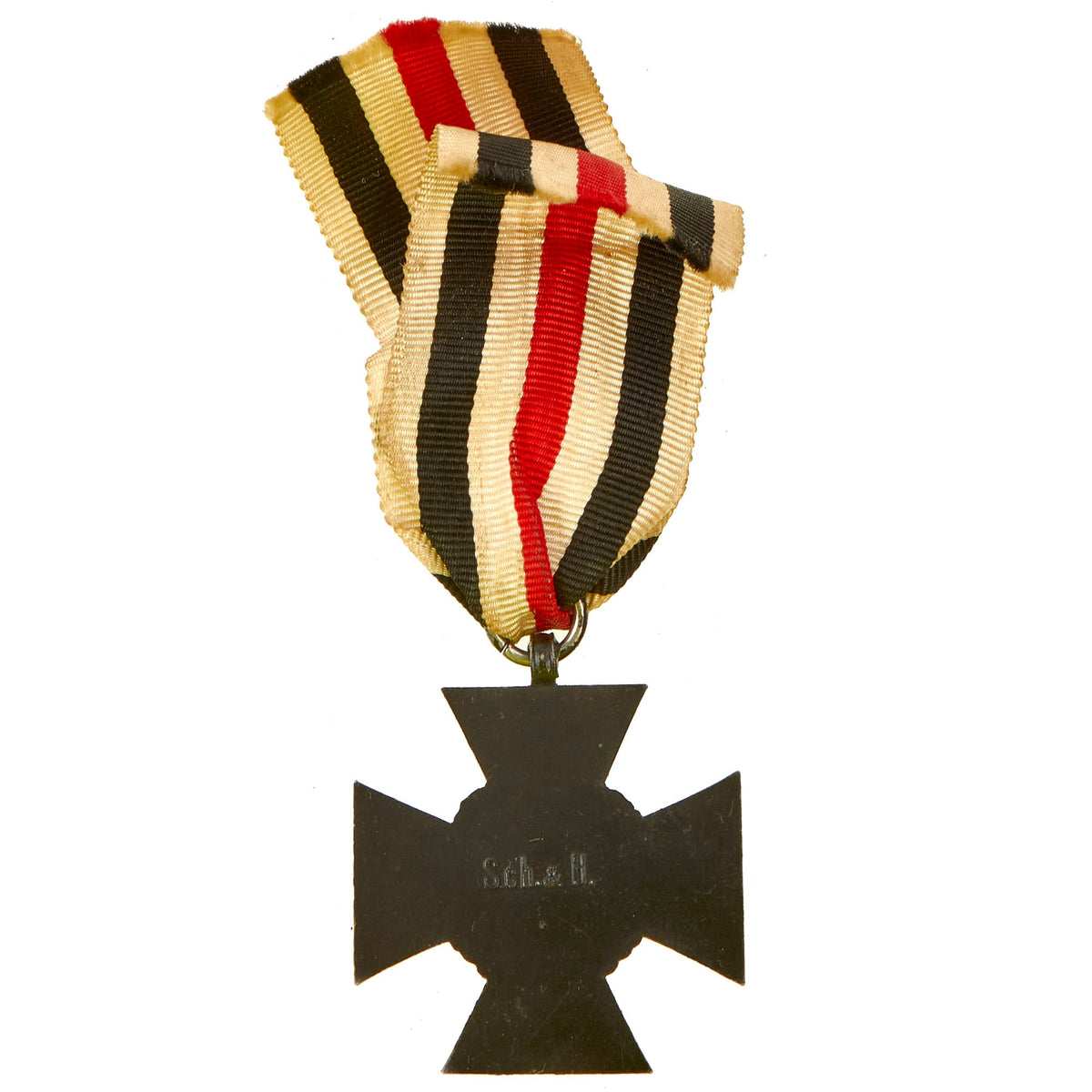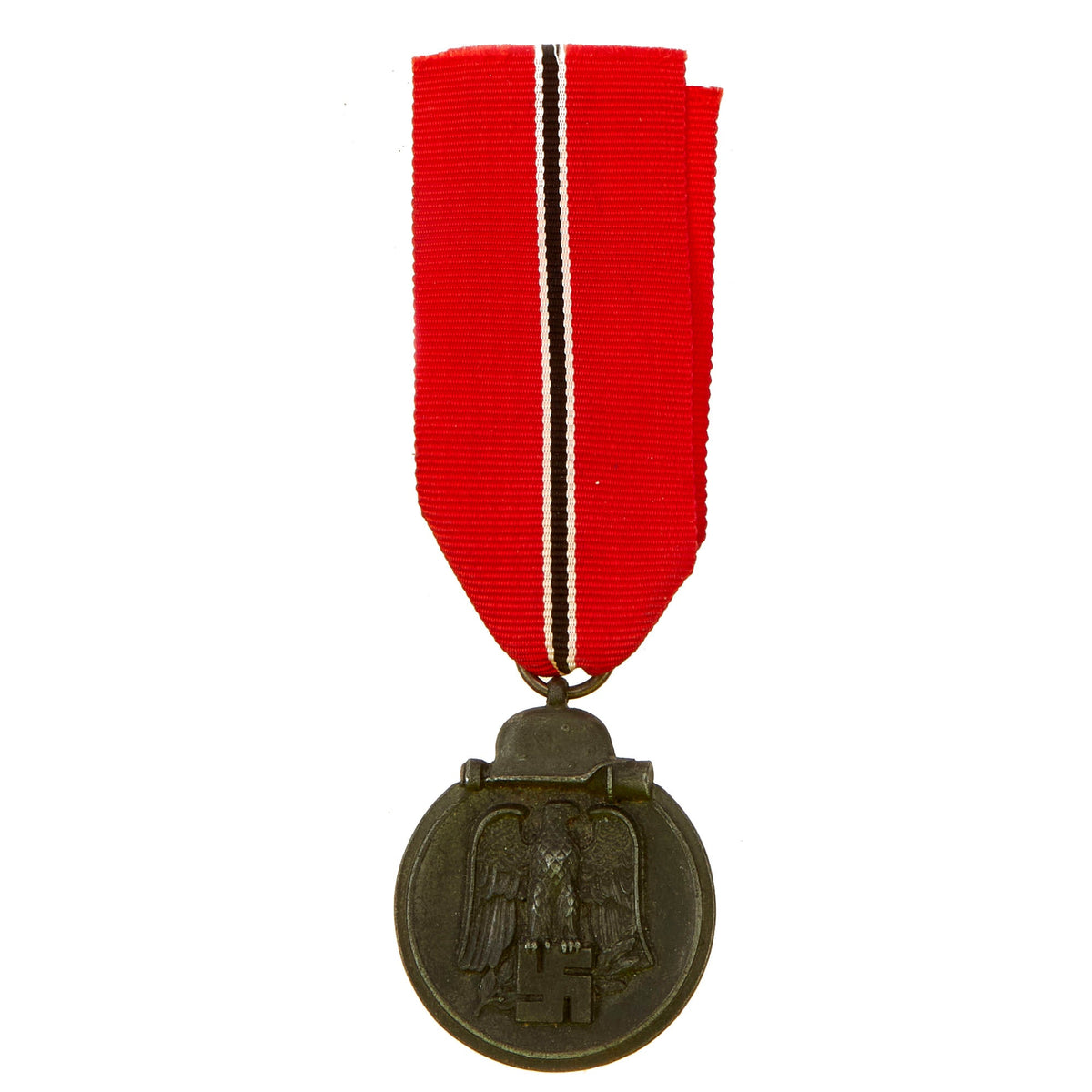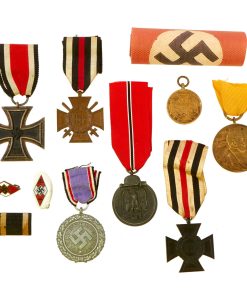Original German WWI & WWII Medal & Insignia Grouping with 1939 EKII, Widow’s Hindenburg Cross, Kaiser Wilhelm Medal & More – 11 Items Original Items
$ 395,00 $ 118,50
Original Items: Only One Set Available. This is a very nice collection of German WWI & WWII Insignia & Awards, which was brought back from the European theater by a USGI after the war was concluded. It includes some a wide variety of medals and insignia, including a 1939 EKII, Rare “Widows” Hindenberg Cross, Eastern Medal, and more!
This lovely set includes:
– One German WWII Iron Cross 2nd Class 1939 (Eisernes Kreuz II. Klasse 1939) with Ribbon. This fine example is in very good condition, with an excellent condition rayon tri-color ribbon. There is light oxidation on the silver components, giving it a lovely tarnished patina.
– One Imperial German WWI Kaiser Wilhelm Memorial Medal with Cut Off Ribbon. THe award is in good condition, still retaining some of the gilt finish, and has a cut off ribbon threaded through the loop. It was most likely removed from a medal bar at some point.
– One Imperial German War Commemorative Medal of 1870/71 for Combatants without ribbon or clasps. This award is in very good condition, still bright with all markings clear.
– One Pre-WWII German WWI Honor Cross of the World War 1914/1918 (Hindenburg Cross) Medal with Swords (for Combat) with ribbon. This example is in very good condition, maker marked on the back with REICHSVERBAND / PFORZHEIM.
– One Rare Pre-WWII German WWI Honor Cross of the World War 1914/1918 (Hindenburg Cross) Medal For Widows and Parents of Fallen Soldiers. Out of the 8 Million Crosses awarded, less than 10% were of this type, which has a magnetic black finished cross, and a ribbon without the outer black stripes. This example is in excellent condition, and is maker marked O16 on the back.
– One German WWII Eastern Front Medal (Ostmedaille) with ribbon. The medal shows signs of minor wear and has minor surface oxidation and build-up. The ribbon is in excellent condition, and properly folded through the hanger ring.
– One German WWII RLB Luftschutz Air Defense Honor Medal 2nd Grade with Short Ribbon. Medal is in very good condition, with the ribbon showing just a bit of staining.
– One German WWII HJ National Youth Organization Cap Badge / Membership Pin, maker marked M1/109 (RZM) on the back, for Glaser & Sohn of Dresden. It is somewhat bent overall, and the enamel has a lot of small cracks in it.
– One German WWII HJ National Youth Organization 21. Juni 1934 Ceramic Tinnie Pin, most likely for attendance or donations.
– One Imperial German WWI Prussian Iron Cross 1914 Ribbon Bar Pin, with functional pinback.
– One Roll of Four Paper German WWII NSDAP Swas Emblems, measuring 18 1/2 inches in length.
A wonderful totally genuine grouping perfect for the German Medal and Insignia collector. Ready to research and display!
More Details on some of the Items in this set:
There is no more iconic German military award than the Iron Cross. The long history of this order began during the Napoleonic Wars. King Friedrich Wilhelm III of Prussia instituted the “Eisernes Kreuz” (Iron Cross) in March of 1813. The award criteria changed somewhat with time, but generally speaking, Iron Crosses could be awarded for individual acts of bravery, or for leadership achievements on the battlefield. The design was created by a Karl Friedrich Schinkel, his choice of the black cross with silver outline was derived from the heraldic emblem of the Teutonic Knights.
There were a number of different type and grades of Iron Cross awards throughout its long history, but the basic details of the most widely awarded grades: The Iron Cross 1st Class and Iron Cross 2nd Class- remained the same. The first class award was a breast badge, with fittings on the reverse to allow it to be worn on the uniform. These fittings varied widely over time and from maker to maker, and could be a simple in and catch, a screw post and retaining disc, or more elaborate setups. The second class award was suspended from a ribbon, originally in the Prussian colors of black and white, later in the Reich colors of black, red and white.
On the original versions of these crosses, in 1813, the front of the iron core of each grade was bare, and only the second class award had ornamentation: a crown over the initials “FW” representing the King, a sprig of oak leaves, and the date 1813. The core was redesigned in 1870, when the cross was re-instituted during the Franco-Prussian War. The reverse ornamentation on the Iron Cross 2nd Class remained the same, but the front of the core on both grades now bore another crown, a “W” representing Kaiser Wilhelm, and the date 1870. This pattern repeated again when the cross was reinstituted for WWI- everything stayed the same, only the date 1870 was replaced with 1914.
The final reinstitution of the cross came in 1939. For this version, the front of the core for both grades bore a swas and the date 1939. The oak leaves, crown and royal initials were removed from the reverse, with only the date 1813 remaining as a reminder of the legacy of this award. In WWII, hundreds of thousands of Iron Cross First Class awards were bestowed, and four and a half million Iron Cross Second Class awards. Iron Crosses were made by a large number of authorized manufacturers. Some variants of these awards were mass produced in huge numbers. Others were made in very limited quantities.
– Kaiser Wilhelm Memorial Medal: The Kaiser Wilhelm Memorial Medal was established on March 22, 1897 by Wilhelm II to celebrate the 100th Birthday of his grandfather, Emperor Wilhelm I. The Centenary Medal was awarded by Prussia to state and university officials, as well as all military officers, non-commissioned officers and enlisted personnel, who had been actively serving in army, navy and Schutztruppe. Medals were also awarded to the surviving veterans of the First Schleswig War, Second Schleswig War, Austro-Prussian War, and the Franco-Prussian War.
The Centenary Medal is made of struck bronze gunmetal from captured cannons. It measures 40 mm in diameter and is suspended from a ribbon 36 mm wide. The obverse depicts a right facing effigy of Wilhelm I in military uniform wearing a mantle and Pickelhaube. To the left of the effigy is the inscription WILHELM / DER / GROSSE / DEUTSCHE / KAISER (William the Great German Emperor). To the right is KOENIG / VON / PREUSSEN (King of Prussia).
The reverse of the medal shows symbols of royal authority including the German State Crown, an orb, sword, and scepter placed upon a pillow surrounded by oak leaves, in the lower half of the medal. To the left is an upward climbing laurel branch. In the upper half is the inscription in six lines ZUM ANDENKEN AN DEN HUNDERTSTEN GEBURTSTAG DES GROSSEN KAISERS WILHELM I. 1797 22.MAERZ 1897 (IN MEMORY OF THE HUNDREDTH BIRTHDAY THE GREAT EMPEROR WILHELM I. 1797–MARCH 22–1897).
– The War Commemorative Medal of 1870/71: The War Commemorative Medal of 1870/71 is a campaign medal presented by Kaiser William I in his capacity as King of Prussia to commemorate service in the Franco Prussian War.
The medal was presented to members of the united German armies. For combat service the medal was bronze, and non-combat service was steel. Each version bore minor differences in inscription and design. The war medal was presented to officers, military physicians, civil servants and men of the German armies who took part in the Franco-Prussian war through 2 March 1871. It was also awarded to the crew of the SMS Augusta for service from 11 December 1870 to 2 March 1871.
Clasps were authorized on the 25th anniversary of the German victory, to commemorate selected battles. The clasps were only allowed to be worn on combatant medals by front line soldiers. They are 6 mm high and 32–39 mm wide and were made of gilt bronze or brass. The claps on this ribbon are: PARIS, VILLIERS, SEDAN, BEAUMONT, GRAVELOTTE-ST. PRIVAT.
The medal for combatants was manufactured from captured bronze cannon barrels.
The obverse shows the crowned Royal cypher of William I over the inscription Dem siegreichen Heere (To the victorious army). Inscribed around the edge is Gott war mit uns, Ihm sei die Ehre (God was with us, to Him be the glory).
The reverse shows a cross with rays between the four arms. In the center of the cross is a laurel wreath surrounding the dates 1870 and 1871. On the edge of the coin is inscribed AUS EROBERTEM GESCHUETZ (From conquered cannon).
The medal for non-combatants is made of steel (this example is bronze). It follows a similar design with only minor deviations. The center inscription on the obverse is Für Pflichttreue im Kriege (For devotion to duty in the war). On the reverse the wreath on the cross is of oak leaves.
Hindenburg Cross:
The Honor Cross of the World War 1914/1918 (German: Das Ehrenkreuz des Weltkriegs 1914/1918), commonly, but incorrectly, known as the Hindenburg Cross was established by Field Marshal Paul von Hindenburg, President of the German Republic, by an order dated 13 July 1934, to commemorate the distinguished deeds of the German people during the First World War. This was Germany’s first official service medal for soldiers of Imperial Germany who had taken part in the war, and where they had since died it was also awarded to their surviving next-of-kin. Shortly after its issuance, the government of NSDAP Germany declared the award as the only official service decoration of the First World War and further forbid the continued wearing of German Free Corps awards on any military or paramilitary uniform of a state or NSDAP Party organization.
The Eastern Medal (Ostmedaille), officially the Winter Battle in the East 1941–42 Medal (Medaille Winterschlacht im Osten 1941/42), was a military award of the Wehrmacht which was created by ordinance of Adolf H on 26 May 1942.
The Eastern Medal was awarded to any member of the Wehrmacht and Waffen-SS “in recognition of experience in the struggle against the Bolshevik enemy and the Russian winter within the period from 15 November 1941 to 15 April 1942.” It was also awarded posthumously to any service member who died in the line of duty within the Soviet Union. It was wryly called the Frozen Meat Medal or the “Order of the Frozen Flesh” (Gefrierfleischorden).
German WWII Air Defense Honor Badge 2nd Grade (Luftschutz Ehrenzeichen zweiter Stufe). The 2nd grade Luftschutz medal was awarded for those who gave meritorious service to the civil air defense of Germany from January 1933 onward. It is constructed out of a die struck aluminum-alloy base that has been silver washed. The obverse features a centrally placed mobile swas in a pebbled field, which is surrounded by FÜR VERDIENSTE IM LUFTSCHUTZ (For Merit in Air Defense). The reverse is marked 1938, also in a pebbled field.
Both sides are surrounded by an oak leaf wreath that is tied together at the bottom. To the top is an integral loop and an aluminum ring. These are fitted with a lavender, white, red and black rayon ribbon.
Fast Shipping with Professional Packaging
Thanks to our longstanding association with UPS FedEx DHL, and other major international carriers, we are able to provide a range of shipping options. Our warehouse staff is expertly trained and will wrap your products according to our exact and precise specifications. Prior to shipping, your goods will be thoroughly examined and securely secured. We ship to thousands clients each day across multiple countries. This shows how we're dedicated to be the largest retailer on the internet. Warehouses and distribution centres can be located throughout Europe as well as the USA.
Note: Orders with more than one item will be assigned a processing date depending on the item.
Before shipping before shipping, we'll conduct a thorough inspection of the items you have ordered. Today, the majority of orders will be delivered within 48 hours. The delivery time will be between 3-7 days.
Returns
The stock is dynamic and we cannot completely manage it because multiple stakeholders are involved, including our factory and warehouse. So the actual stock may alter at any time. It's possible that you may not receive your order once the order has been made.
Our policy is valid for a period of 30 days. If you don't receive the product within 30 days, we are not able to issue a refund or an exchange.
You can only return an item if it is unused and in the same state as the day you received it. You must have the item in its original packaging.
Related products
Uncategorized
Uncategorized
Uncategorized
Uncategorized
Uncategorized
Uncategorized
Uncategorized
Armoured Fighting Vehicles of the World: AFVs of World War One (Hardcover Book) New Made Items
Uncategorized
Uncategorized
Uncategorized
Angolan Rebel 1970s era 60mm Inert Display Mortar from Angolan Civil War Original Items
Uncategorized
Uncategorized
Australian WWII Owen MK1 Machine Carbine SMG Custom Fabricated Replica with Sling Original Items
Uncategorized
Uncategorized
Uncategorized
Band of Brothers ORIGINAL GERMAN WWII Le. F.H. 18 10.5cm ARTILLERY PIECE Original Items
Uncategorized
